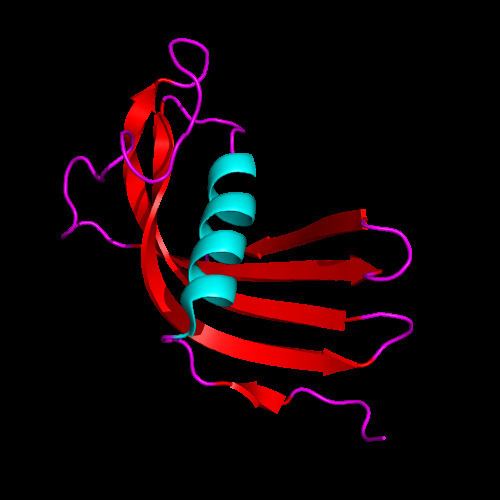The cystatins are a family of cysteine protease inhibitors which share a sequence homology and a common tertiary structure of an alpha helix lying on top of an anti-parallel beta sheet. The family is subdivided as described below.
Cystatins show similarity to fetuins, kininogens, histidine-rich glycoproteins and cystatin-related proteins. Cystatins mainly inhibit peptidase enzymes (another term for proteases) belonging to peptidase families C1 (papain family) and C13 (legumain family). They are known to mis-fold to form amyloid deposits and are implicated in several diseases.
The cystatin family includes:
The Type 1 cystatins, which are intracellular and are present in the cytosol of many cell types, but can also appear in body fluids at significant concentrations. They are single-chain polypeptides of about 100 residues, which have neither disulfide bonds nor carbohydrate side-chains. Type 1 cystatins are also known as Stefins (after the Stefan Institute where they were first discovered )The Type 2 cystatins, which are mainly extracellular secreted polypeptides are largely acidic, contain four conserved cysteine residues known to form two disulfide bonds, may be glycosylated and/or phosphorylated. They are synthesised with a 19- to 28-residue signal peptide. They are broadly distributed and found in most body fluids.The Type 3 cystatins, which are multidomain proteins. The mammalian representatives of this group are the kininogens. There are three different kininogens in mammals: H- (high-molecular-mass, InterPro: IPR002395) and L- (low-molecular-mass) kininogen, which are found in a number of species, and T-kininogen, which is found only in rats.Unclassified cystatins. These are cystatin-like proteins found in a range of organisms: plant phytocystatins, fetuin in mammals, insect cystatins, and a puff adder venom cystatin, which inhibits metalloproteases of the MEROPS peptidase family M12 (astacin/adamalysin). Also, a number of the cystatin-like proteins have been shown to be devoid of inhibitory activity.CST1, CST2, CST3 (cystatin C, a marker of kidney function), CST4, CST5, CST6, CST7, CST8, CST9, CST11, CSTA (cystatin A), CSTB (cystatin B)van Wyk et al found some 19 different cystatins similar to oryzacystatin-I in the soybean along with related cysteine proteases.
Chicken cystatin quickly passed the membrane of MCF-10A neo T cells and inhibited cathepsin B when it was acylated with fatty acyl residues of 6-18 carbon atoms.

